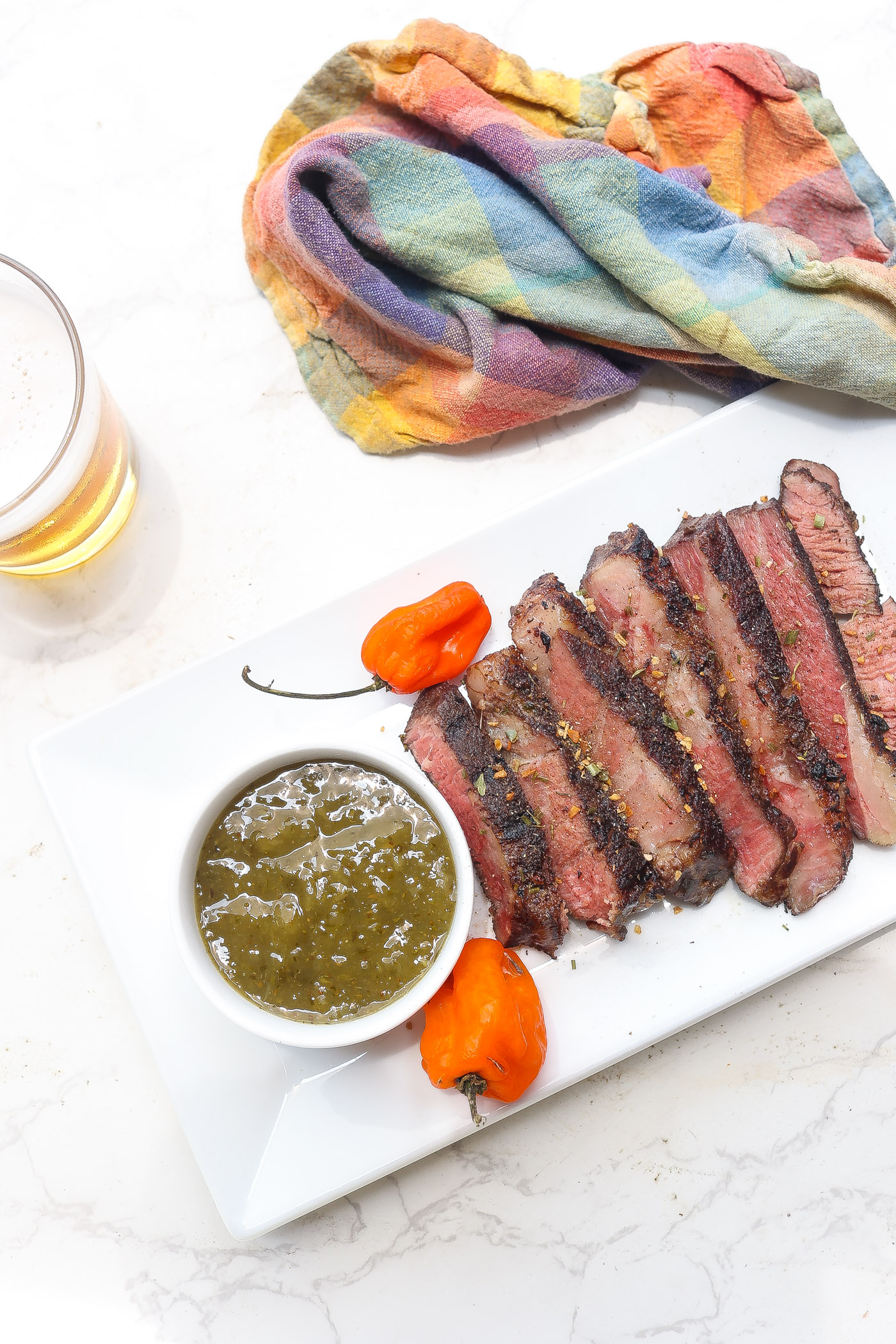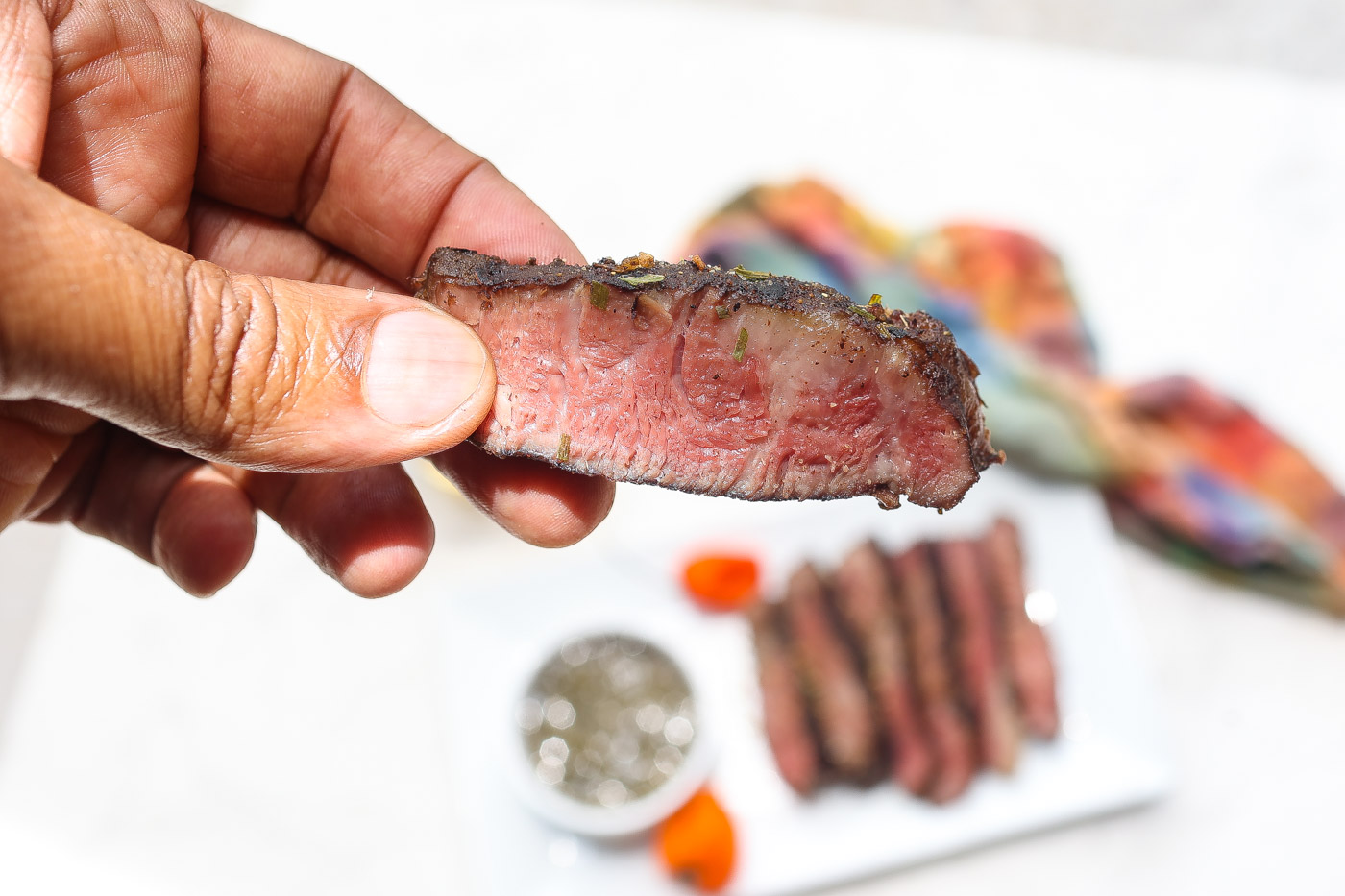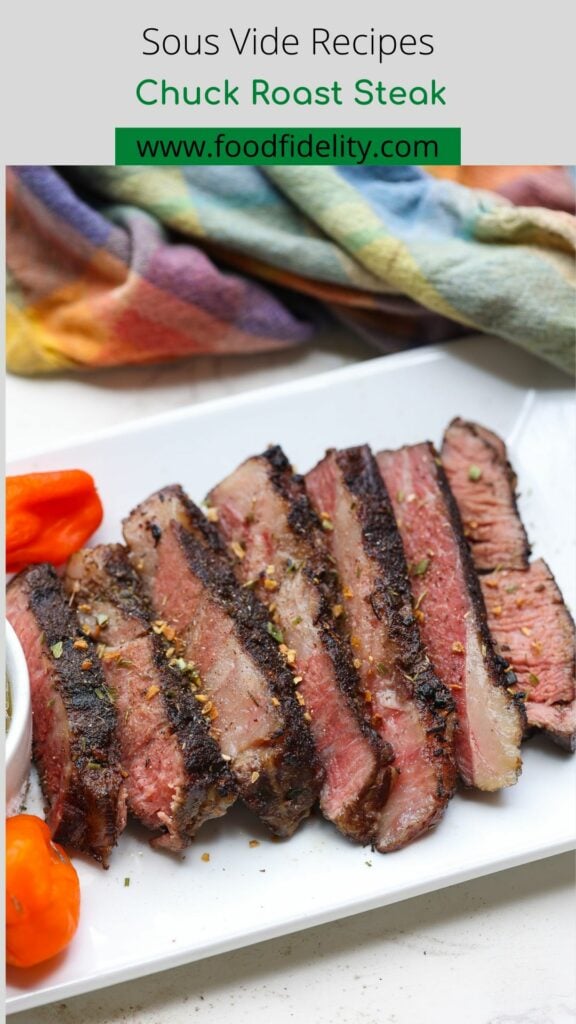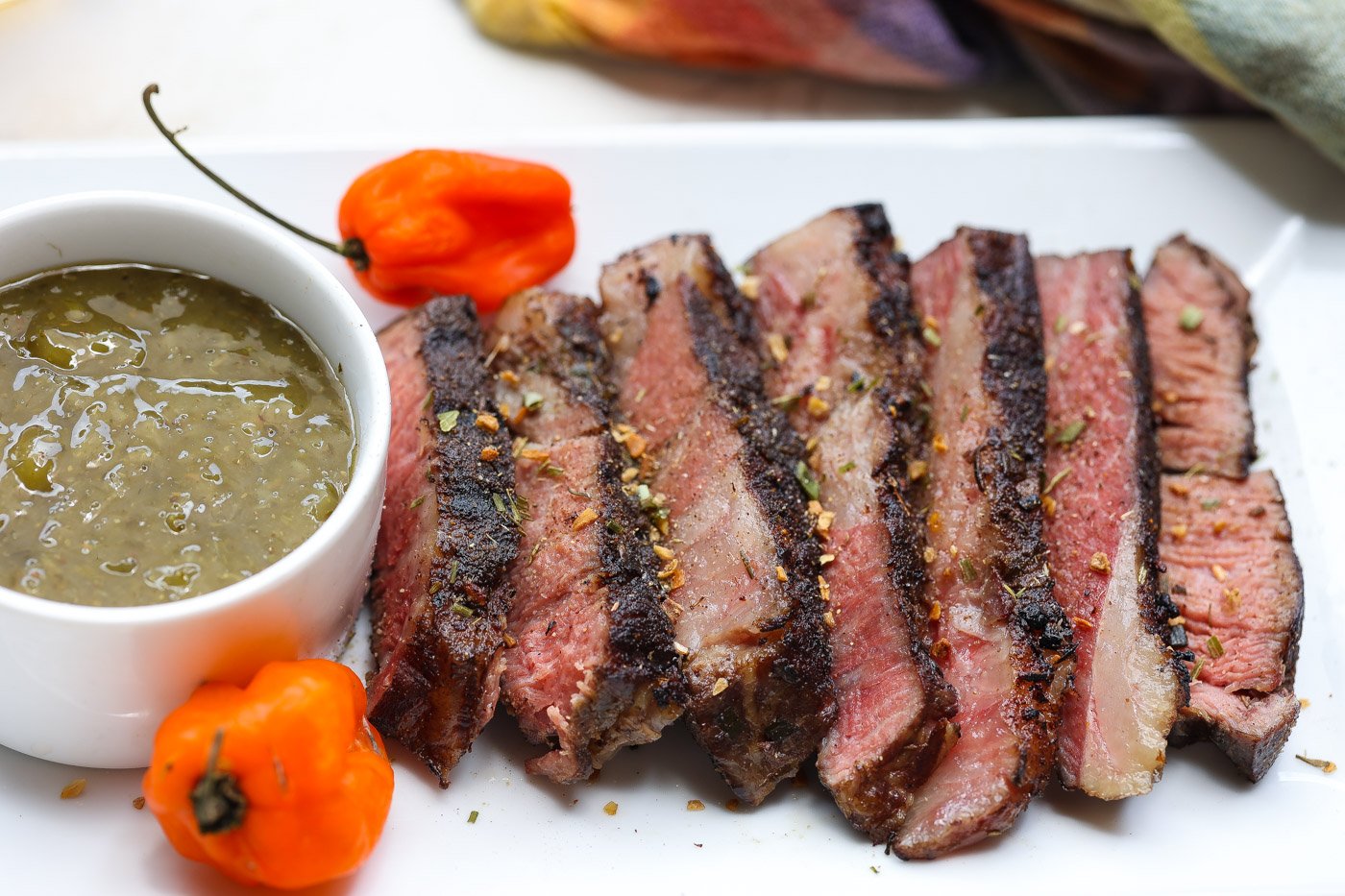This post may contain affiliate links via Amazon's affiliate advertising program. See privacy policy
Cooking a chuck roast using the sous vide method with jerk seasoning is an exciting fusion of culinary techniques and flavors. This approach combines the precision and consistency of sous vide cooking with the vibrant, spicy, and aromatic notes of Caribbean jerk seasoning. The result is a tender, juicy chuck roast steak that bursts with complex and bold flavors, offering a delightful twist on a traditional cut of beef.
Related Beef Recipes:
Tender sous vide chuck steak substituting as a much cheaper and equally as flavorful alternative to the choice cut ribeye.
Picture this: a tender, succulent chuck roast steak, slow-cooked to perfection with an innovative technique known as sous vide. This method, born from the marriage of science and culinary artistry, takes this humble cut of meat and transforms it into a symphony of flavor and tenderness.
If you’re a foodie, you know that cooking can be an art form. Whether it's rustling up some traditional soul food favorites or trying your hand at something new and inventive, the kitchen can provide countless opportunities to elevate and inspire.
That said, there’s nothing quite like discovering tasty new methods of attending to those old classics we all love so much—and when it comes to making the perfect steak dinner for any occasion, sous vide chuck steak is about as scrumptious as they come!
With sous vide, we embark on a journey where precision and patience meet, resulting in a melt-in-your-mouth experience like no other. So sit back, savor the anticipation, and allow me to introduce you to the soulful delight of sous vide chuck roast steak.
Chuck roast isn't normally the meat cut of choice for sous vide cooking, but these steaks are a great value alternative to pricier cuts like a ribeye. Note chuck roast goes by other names and/or potentially come from the same area are the chuck eye, blade roast, shoulder roast, shoulder steak, arm steak, arm roast, cross-rib roast, or seven-bone roast. Some butchers also sell the chuck generically labeled as “pot roast"

What is Sous Vide Cooking
Sous vide cooking is a culinary technique that involves cooking food in a precisely controlled water bath at a consistent low temperature for an extended period. The term "sous vide" is French for "under vacuum," referring to the initial practice of vacuum-sealing food in plastic bags before cooking. I like the sous vide method because you get better tenderness than a slow cooker and you can dial up the exact internal cooking temperature desired.
The process starts by placing the food, such as meat, fish, vegetables, or even desserts, in a sealed bag. The bag is then submerged in a sous vide bath heated to a specific temperature using a sous vide immersion circulator or a specialized water oven. The immersion circulator maintains the water at a constant temperature, ensuring even cooking throughout.
The low and precise temperature used in sous vide cooking allows for gentle and gradual cooking, which helps retain the food's natural flavors, moisture, and tenderness. It also ensures consistent doneness from edge to edge, eliminating the risk of overcooking. I love that you can get perfectly cooked vegetables every time.
The cooking times in sous vide recipes can be longer compared to traditional methods, but the result is often a more tender and flavorful outcome. After the desired cooking time, the food can be finished with a quick sear, grill, or broil to develop a delicious crust or char on the exterior.
Sous vide cooking offers several benefits. It provides greater control over the cooking process, allowing chefs and home cooks to achieve precise doneness and texture. It is especially useful for cooking delicate proteins, such as fish and poultry, ensuring they remain juicy and tender. Additionally, it can enhance flavors by infusing ingredients, such as herbs, spices, or marinades, into the food during the cooking process. It is great for large beef cuts like tender prime rib, brisket, pot roast, etc.
Beats and Eats (music to pair with chuck steak)
This is one of those recipes where it seems like you have different things competiting against each other, but in actuality they really complement each other well. Chuck roast is typically slow braised or eaten in a long simmered stew. However we're cooking it as if it were a steak and it's delicious.
Ingredients Needed To Make Sous Vide Chuck Steak
To make sous vide chuck roast steak, you will need the following ingredients:
- Beef chuck roast steak: Look for a well-marbled cut of chuck roast, preferably boneless, weighing around 1 to 1.5 pounds. This cut of beef is known for its rich flavor and tenderness.
- Jerk Seasoning: Season the steak with jerk seasoning or simply salt and pepper.
Optional ingredients for additional flavor:
- Aromatics: Consider adding aromatics like sliced onions, fresh garlic cloves, or shallots to impart depth and complexity to the dish.
- Cooking fat: A small amount of cooking fat, such as olive oil or butter, can be used to enhance the richness and browning of the steak during the finishing step.
These ingredients form the foundation for a delicious sous vide chuck roast steak. However, feel free to customize the seasoning and flavors according to your preferences, adding any additional ingredients that you enjoy.
Cooking Chuck Roast Sous Vide (step by step)
Step 1: Preheat the water bath:
Fill large sous vide container or pot with water and attach a sous vide circulator. Set the water bath to the desired temperature for your chuck steak, typically around 130-135°F (54-57°C) for medium-rare. Allow the water to come to the set temperature.
Step 2: Season the chuck steak:
Season the chuck steak generously with the dry seasoning on all sides. You can also add any optional herbs, spices, or aromatics at this stage to enhance the flavors. Beyond jerk seasoning you can use a spice mix that includes spices like finely ground pepper, garlic powder, paprika, and allspice.
Step 3: Vacuum seal the beef roast:
Place the seasoned roast in a vacuum-sealable bag, heavy-duty zip-top bag, or sous vide bag. If using a zip-top bag, use the water displacement method: partially seal the bag, then slowly lower it into the water bath, allowing the water pressure to push out the air. Seal the bag completely once most of the air is removed.
Step 4: Sous vide cooking:
Carefully place the sealed bag with the chuck steak into the preheated water bath, ensuring it is fully submerged. Use a clip or weigh it down to keep the bag from floating. Allow the steak to cook for at least 24 hours, depending on the desired level of tenderness. Longer cooking times result in more tender meat.
Step 5: Finishing the steak:
Once the sous vide cooking time is complete, remove the bag from the water bath. Carefully take the steak out of the bag and pat it dry with paper towels.
Step 6: Searing the steak:
Preheat a cast iron skillet or grill over medium high heat or higher. Add a small amount of cooking fat, such as olive oil or butter, to the skillet. Sear the chuck steak for about 1-2 minutes per side, or until a golden-brown crust forms. This step adds a flavorful exterior to the steak.
Step 7: Cut the steak:
Place the now super tender chuck steak on a cutting board. Cut against the grain for maximum tenderness. Sprinkle some of the jerk seasoning, flaky sea or kosher salt on top and serve. Your dinner guests will absolutely love it.

What to serve with steak
When it comes to serving steak, there are numerous delicious options for side dishes that complement its rich flavors. Here are some popular choices:
- Roasted Vegetables: Roasted vegetables like potatoes, carrots, Brussels sprouts, or asparagus make excellent accompaniments to steak. Seasoned with herbs and spices and roasted to perfection, they provide a hearty and flavorful addition to the meal.
- Mashed Potatoes: Creamy mashed potatoes are a classic side dish that pairs well with steak. Whether you prefer traditional mashed potatoes or variations like garlic mashed potatoes or loaded mashed potatoes with cheese and bacon, they offer a comforting and satisfying element.
- Grilled Vegetables: Grilling vegetables like zucchini, bell peppers, eggplant, or corn on the cob adds a smoky char and enhances their natural sweetness. Grilled vegetables provide a lighter and refreshing contrast to the richness of the steak.
- Salad: A fresh salad can provide a refreshing contrast to the hearty flavors of steak. Opt for a green salad with mixed greens, cherry tomatoes, cucumber, and a tangy vinaigrette. You can also add ingredients like avocado, blue cheese, or nuts for added texture and flavor.
- Creamed Spinach: Creamed spinach is a classic steakhouse side dish that complements the richness of the steak. The creamy, flavorful spinach pairs well with the meat and adds a touch of elegance to the meal.
- Mushrooms: Sautéed or grilled mushrooms make a delectable addition to steak. Their earthy flavor and tender texture perfectly complement the meat. You can cook them with garlic, butter, and herbs for added depth of flavor.
- Baked or Grilled Potatoes: Baked or grilled potatoes, such as baked russet potatoes or grilled sweet potatoes, are hearty and satisfying options. Top them with sour cream, chives, cheese, or bacon to enhance their flavors.
- Steak Sauce or Compound Butter: Consider serving your steak with a flavorful sauce or compound butter. Classic choices include mushroom sauce, peppercorn sauce, or garlic herb butter. These add an extra layer of richness and flavor to the steak.
Remember, the choice of side dishes ultimately depends on your personal preferences and the occasion. Feel free to mix and match or experiment with different combinations to create a well-rounded and satisfying meal that perfectly complements your steak.

Cooking Considerations and Tips For Cooking Sous Vide Chuck Roast
When cooking sous vide chuck roast, there are several considerations and tips to keep in mind to achieve the best results. Here are some guidelines to follow:
- Time and Temperature: Chuck roast is a tough cut of meat that benefits from long, slow cooking to break down the connective tissues and become tender. Set your sous vide water bath to a temperature of around 130-135°F (54-57°C) for medium-rare or 135-145°F (57-63°C) for medium doneness. The cooking time can range from 8 to 24 hours, depending on the desired level of tenderness.
- Seasoning: Season the chuck roast before vacuum-sealing or bagging it for sous vide cooking. You can also add additional seasonings like herbs, spices, or aromatics to enhance the flavors. However, be careful not to use too much salt as it can concentrate during the cooking process.
- Proper Sealing: Ensure the chuck roast is properly sealed in a vacuum-sealable bag or heavy-duty zip-top bag to prevent any water from entering. Proper sealing ensures even cooking and maintains the moisture and flavors of the meat.
- Water Displacement Method: If using a zip-top bag, utilize the water displacement method to remove excess air. Partially seal the bag, leaving a small opening, and slowly submerge it in the water bath, allowing the water pressure to push out the air. Once most of the air is removed, seal the bag completely.
- Proper Immersion: Submerge the sealed chuck roast completely in the water bath, ensuring it is fully surrounded by the water. Use a clip or weigh it down to prevent the bag from floating. This guarantees even cooking throughout the meat.
- Insulation: For longer cooking times, consider using an insulated container or wrapping the water bath with towels to minimize heat loss. This helps maintain a consistent temperature throughout the cooking process.
- Post-Sous Vide Searing: After the chuck roast is done cooking in the water bath, it is essential to give it a flavorful crust through searing. Pat the meat dry with paper towels and sear it on a hot skillet or grill for a couple of minutes per side. This step adds texture and enhances the overall taste.
Frequently Asked Questions (FAQs) About Sous Vide Steak Cooking
What is the recommended temperature and cooking time for sous vide chuck steak?
For medium-rare chuck steak, set the sous vide water bath to around 130-135°F (54-57°C) and cook for at least 24 hours. Adjust the time based on your desired level of tenderness. For medium doneness, increase the temperature to 135-145°F (57-63°C).
Can I season the chuck steak before sous vide cooking?
Yes, it is recommended to season the chuck steak with salt and pepper before vacuum-sealing or bagging it. You can also add additional herbs, spices, or aromatics to enhance the flavors. I seasoned mine with jerk seasoning spice.
Should I sear the chuck steak before or after sous vide cooking?
It is not necessary to sear the chuck steak before sous vide cooking. Searing is typically done after sous vide cooking to develop a flavorful crust. Pat the meat dry and sear it on a hot skillet or grill for a couple of minutes per side for a delicious finish.
Do I need a vacuum sealer?
It's ideal but not a requirement. A vacuum sealed bag makes it easy to protect the food from water and generally it is easier to keep the food submerged. However, you can use ziplock bags combined with the water displacement method in place of vacuum sealing.
Can I cook frozen chuck steak sous vide?
Yes, you can cook frozen chuck steak sous vide. However, it will require a longer cooking time. Add an additional 1-2 hours to the recommended cooking time for thawed chuck steak.
Special Equipment Needed
You will definitely need a sous vide machine and possibly an indoor grill pan. I use the Anova precision as my sous vide cooker of choice. I like to sear my meat cuts after the sous vide process. I typically use a cast iron grill pan.
Make This Sous Vide Recipe
After all’s said and done, it’s time to bring it all back around. Let’s put the sous vide chuck steak dream into reality! With a cut like this, you won’t have to worry about being too tough or too dried out.
But that said, don’t forget the sides — nothing goes better than some slow roasted garlic-infused potatoes and asparagus seasoned with some of your favorite herbs. This ain’t just any sous vide chuck steak recipe, this one is for the books. So go ahead, prepare this bundle of deliciousness today and treat your taste buds (and guests!) to a special meal. You won't regret it – now, get to cookin'!
If you make this sous vide chuck steak recipe or any other from the site, please come back and leave me a comment below with your feedback. Definitely take a photo of the dish and be sure to tag #foodfidelity so that I can see them.
You can also keep up with my food exploits as well as original recipes! You can find me on Instagram, Facebook, Twitter, and Pinterest. If you like any of the music you find on the site, visit me at Spotify to find curated monthly playlists.
Lastly, go to my YouTube channel and subscribe to be notified when new weekly videos are uploaded.
Ingredients
- 4-6 lbs Beef chuck roast
- 2 tablespoon Dry Jerk Seasoning
Optional ingredients for additional flavor:
- Herbs - fresh thyme
- 2 Garlic cloves smashed
- 1 tablespoon Olive Oil
Instructions
Step 1: Preheat the water bath:
- Fill large sous vide container or pot with water and attach a sous vide circulator. Set the water bath to the desired temperature for your chuck steak, typically around 130-135°F (54-57°C) for medium-rare. Allow the water to come to the set temperature.
Step 2: Season the chuck steak:
- Season the chuck steak generously with the dry seasoning on all sides. You can also add any optional herbs or aromatics at this stage to enhance the flavors.
Step 3: Vacuum seal the steak:
- Place the seasoned roast in a vacuum-sealable bag, heavy-duty zip-top bag, or sous vide bag. If using a zip-top bag, use the water displacement method: partially seal the bag, then slowly lower it into the water bath, allowing the water pressure to push out the air. Seal the bag completely once most of the air is removed.
Step 4: Sous vide cooking:
- Carefully place the sealed bag with the chuck steak into the preheated water bath, ensuring it is fully submerged. Use a clip or weigh it down to keep the bag from floating if necessary. Allow the steak to cook for at least 24 hours, depending on the desired level of tenderness. Longer cooking times result in more tender meat.
Step 5: Finishing the steak:
- Once the sous vide cooking time is complete, remove the bag from the water bath. Carefully take the steak out of the bag and pat it dry with paper towels.
Step 6: Searing the steak:
- Preheat a cast iron skillet or grill over high heat. Add a small amount of cooking fat, such as olive oil or butter, to the skillet. Sear the chuck steak for about 1-2 minutes per side, or until a golden-brown crust forms. This step adds a flavorful exterior to the steak.
Step 7: Cut the steak:
- Place the now super tender chuck steak on a cutting board. Cut against the grain for maximum tenderness. Sprinkle some of the jerk seasoning on top and serve. Your dinner guests will absolutely love it.
Notes
- Time and Temperature: Chuck roast is a tough cut of meat that benefits from long, slow cooking to break down the connective tissues and become tender. Set your sous vide water bath to a temperature of around 130-135°F (54-57°C) for medium-rare or 135-145°F (57-63°C) for medium doneness. The cooking time can range from 8 to 24 hours, depending on the desired level of tenderness.
- Seasoning: Season the chuck roast before vacuum-sealing or bagging it for sous vide cooking. You can also add additional seasonings like herbs, spices, or aromatics to enhance the flavors. However, be careful not to use too much salt as it can concentrate during the cooking process.
- Proper Sealing: Ensure the chuck roast is properly sealed in a vacuum-sealable bag or heavy-duty zip-top bag to prevent any water from entering. Proper sealing ensures even cooking and maintains the moisture and flavors of the meat.
- Water Displacement Method: If using a zip-top bag, utilize the water displacement method to remove excess air. Partially seal the bag, leaving a small opening, and slowly submerge it in the water bath, allowing the water pressure to push out the air. Once most of the air is removed, seal the bag completely.
- Proper Immersion: Submerge the sealed chuck roast completely in the water bath, ensuring it is fully surrounded by the water. Use a clip or weigh it down to prevent the bag from floating. This guarantees even cooking throughout the meat.
- Insulation: For longer cooking times, consider using an insulated container or wrapping the water bath with towels to minimize heat loss. This helps maintain a consistent temperature throughout the cooking process.
- Post-Sous Vide Searing: After the chuck roast is done cooking in the water bath, it is essential to give it a flavorful crust through searing. Pat the meat dry with paper towels and sear it on a hot skillet or grill for a couple of minutes per side. This step adds texture and enhances the overall taste.


